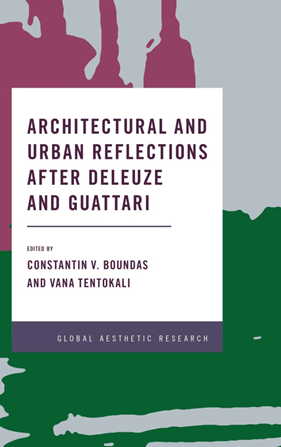Boundas Constantine V., Tentokali Vana (eds) (2018)
Architectural and Urban Reflections after Deleuze and Guattari.
London: Rowman and Littlefeld.
Πρόκειται για μια προ(σ)κληση να σκεφτουμε
πως ο φιλοσοφικος λογος των Deleuze και Guattari διαταρασσει τον αρχιτεκτονικο λογο,
ο οποιος αδιακοπα εστιαζεται στον πειραματισμο του γιγνεσθαι στον σχεδιασμο
και στον επαναπροσδιορισμο του αστικου και τοπιακου χωρου.


Description
“The post humanist movement which currently traverses various disciplines in the arts and humanities, as well as the role that the thought of Deleuze and Guattari has had in the course of this movement, has given rise to new practices in architecture and urban theory. This interdisciplinary volume brings together architects, urban designers and planners, and asks them to reflect and report on the (built) place and the city to come in the wake of Deleuze and Guattari”.
Table of contents
Introduction, Constantin Boundas and Vana Tentokali
Part One – Architecture and Urbanism: Arts of the Built Space
Schizoanalytic City, Andrew Ballantyne
Deleuze, Space and the Architectural Fragment, Marko Jobst
Architectural Translations of Deleuze and Guattari’s Thought on the Concept of Place, Dimitra Chatzisavva
The Skin of the Public Space, Vana Tentokali and Constantin Boundas
Bodies without Organs and Cities without Architecture, Chris SmithPart Two – Architectural and Urbanist Tool Boxes
Gilles Deleuze and Chaos Theory, Stathis-Alexander Zoulias
A Thousand Models of Realization: Toward a Deleuzoguattarian Critical Urban Theory, Keith Harris
Non-Correlational Athens, Stavros Kousoulas
Architecture at the Age of Its Digital Production: The Force, Differentiation and Humanity of the Fold as an Architectural Principle, Constantinos Proimos
Design of Earth Movement: Objects, Buildings and Environment Conceived as Landscape Formations, Konstantinos Moraitis
Spatial Transcriptions of the Concept of the Fold in Architecture as a Landscape Sensitive Approach, Anthi VerykiouPart Three – Vital Materiality
Laocoon and the Snakes of History, Bernard Cache
Reterritorializing Concrete as an Actor of Comfort in Architecture, Athena Moustaka
Radicalizing Architecture by redefining the Monument, Mike Hale
Diagrammatic Narratives: Graphic Fields of Rupture and Catastrophe, Anthia Kosma
The Concept of the Map in the Homeric Odyssey, Aspasia Kouzoupi
Part Four – The Clinical
From the Exhaustion of the Dogmatic Image of Thought that Circumscribes Architecture to Feminist Practices of Joy, Hélène FrichotBibliography
Index
Contributor Biographies
